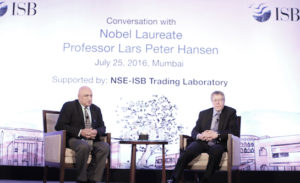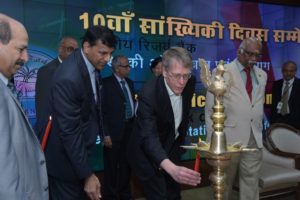In July my spouse, Grace Tsiang, and I visited Mumbai and Hyderabad in India. Our trip was orchestrated in part by our friend and distinguished scholar Ravi Jagannathan, who is affiliated with and an external advisor to one of our hosts, the Indian School of Business (ISB). My other host was the Reserve Bank of India (RBI).

During my visit, I gave two lectures and a public interview, participated in a formal exchange with Bhagwan Chowdhry of UCLA about my research and perspectives, and had many other opportunities to share insights. It was my first visit to this interesting and important country that faces many challenges as it nurtures growth and transitions to a market economy. To my amusement, the Indian press, like the media in other countries, presumed I would arrive as an expert on their economy.
My first formal talk was at the RBI in a celebration of the 10th Statistics Day in India. The initial speaker was Raghu Rajan, who is the outgoing governor at the Reserve Bank. Raghu is about to return to the University of Chicago, which is welcome news for the University, but is a loss to the RBI of a distinguished and perceptive economist. My talk focused on decision-making, financial market behavior, and policy design in environments with a high degree of statistical complexity and where there is limited understanding. I proposed ways to nurture productive interaction between statistical constructs and practical decision making both “inside the economic models’’ we build and “outside the models” when providing inputs into the design of policy. I suggested frameworks that acknowledge in a tractable and revealing way the uncertainties that we face, including the potential for model misspecification. Tools from statistics are valuable inputs into such analyses.
My talk at ISB followed a similar theme but focused on gaining a better understanding of financial market behavior and included a more formal analysis. In economists’ fascination with psychology and behavior, discerning the role of the statistical complexity in the underlying economic environment too often is shunted to the background.
Because it was my first time visiting India, I looked forward to discovering more about its economy. One of my superb students, Aaron Pancost, who is about to finish his Ph.D. degree, studies the aggregate impact of financing restrictions on Indian firms. While I have followed his work with great interest, my knowledge and understanding of the Indian economy was limited, despite the press’s impression. Typically, it is the advisee and not the advisor who is sent off to do the field work. For my benefit, I found the roles reversed.

I also benefitted from a variety of interactions. At the RBI my talk followed that of Raghu Rajan. He has been subject to some not very compelling criticisms, and his talk went through evidence that is most germane to the policy undertaken at the bank under his leadership. I also was provided in advance with some very nice briefings from some faculty affiliated with the ISB and learned more from private conversations with them. The ISB and Adi Burjorji Godrej, a well-respected industrialist and businessman, hosted a luncheon where I received some insights from private sector leaders.
In India, as elsewhere, there is public outcry to let conventional monetary policy solve a wide array of problems. This occurs, I believe, because monetary policy is easier for politicians and the media to target in their commentary than, say, financial market oversight and long-term fiscal sustainability. The RBI has focused recently on stabilizing inflation with the idea that this will, in the longer term, help the Indian economy sustain growth. I am sympathetic with the perspective and found Raghu’s discussion of why inflation is not yet “a solved problem” for the Indian economy to be credible.
Many economists who I talked with compared the performance of publicly-owned and privately-owned banks. The private banks are evidently more efficient and better willing or able to provide resources to new enterprises. Market valuations reflect these differences. This led me and others to ask, “Why not privatize the publicly-owned banks?’’
The answer is apparently that it is politically infeasible to do so. As a partial alternative, the RBI has recently insisted that public sector banks produce more transparent balance sheets. This is a productive step that will help with external assessments of bank value and productivity. Over time, I hope that private banks are given the opportunity to play an even more dominant role in the provision of financing for enterprises.
India has also recently witnessed notable and impressive increases in foreign direct investment (FDI). The contribution of FDI to overall investment remains modest, however. Continuing to make India attractive to external investors is promising, but labor market restrictions remain a serious impediment to firms’ ability to expand their productive activities and for nurturing new enterprises.
Finally, I gained a new perspective on the importance of language in enhancing economic development. India’s population has a rich cultural diversity, which extends to many languages, but secondary schools use Hindi and English in addition to the local languages. The common fluency in English facilitates communication among regions in India, and, notably, it is a substantial advantage for India’s participation in the world economy compared to other Asian nations.
While of great value, this crash course on the Indian macroeconomy still does not transform me into an expert. I have more to learn about their fascinating and important economy. In this case, however, I return to Chicago with a better perspective on Aaron’s research and many new insights about India.
— Lars Peter Hansen
Photo of Lars Peter Hansen and Bhagwan Chowdhry (top) courtesy of Indian School of Business.
Photo of Lars Peter Hansen and Raghu Rajan (bottom) courtesy of Royal Bank of India.
